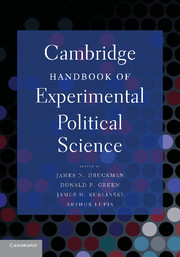Book contents
- Frontmatter
- Contents
- List of Tables
- List of Figures
- Contributors
- Acknowledgments
- INTRODUCTION
- PART I DESIGNING EXPERIMENTS
- PART II THE DEVELOPMENT OF EXPERIMENTS IN POLITICAL SCIENCE
- PART III DECISION MAKING
- PART IV VOTE CHOICE, CANDIDATE EVALUATIONS, AND TURNOUT
- PART V INTERPERSONAL RELATIONS
- PART VI IDENTITY, ETHNICITY, AND POLITICS
- PART VII INSTITUTIONS AND BEHAVIOR
- PART VIII ELITE BARGAINING
- 28 Coalition Experiments
- 29 Negotiation and Mediation
- 30 The Experiment and Foreign Policy Decision Making
- PART IX ADVANCED EXPERIMENTAL METHODS
- AFTERWORD
- Name Index
- Subject Index
- References
28 - Coalition Experiments
Published online by Cambridge University Press: 05 June 2012
- Frontmatter
- Contents
- List of Tables
- List of Figures
- Contributors
- Acknowledgments
- INTRODUCTION
- PART I DESIGNING EXPERIMENTS
- PART II THE DEVELOPMENT OF EXPERIMENTS IN POLITICAL SCIENCE
- PART III DECISION MAKING
- PART IV VOTE CHOICE, CANDIDATE EVALUATIONS, AND TURNOUT
- PART V INTERPERSONAL RELATIONS
- PART VI IDENTITY, ETHNICITY, AND POLITICS
- PART VII INSTITUTIONS AND BEHAVIOR
- PART VIII ELITE BARGAINING
- 28 Coalition Experiments
- 29 Negotiation and Mediation
- 30 The Experiment and Foreign Policy Decision Making
- PART IX ADVANCED EXPERIMENTAL METHODS
- AFTERWORD
- Name Index
- Subject Index
- References
Summary
The literature on coalition experiments is blessed by a close connection between theory and empirical work, using both experimental and field data. In political science, the main research goal has been to understand the formation of coalition governments in multiparty democracies. Although other aspects of coalitions could be considered (e.g., coalition stability or the creation and maintenance of military alliances), they have not been the focus of much existing research. We therefore focus on experiments in coalition formation.
The goal of this chapter is not to provide an accurate description of the complete history of coalition experiments, but rather to discuss some of the key questions that continue to occupy researchers today. For example, much of the recent experimental literature has tested noncooperative models of coalition government. Although there has been a substantial amount of research on solution concepts from cooperative game theory, its performance to explain experimental data has long been considered unsatisfactory, leading some researchers such as Gamson (1964) to propose an “utter confusion” theory.
In addition to testing of theoretical models, experiments can also be used to supplement field studies. For example, field studies (Martin and Stevenson 2001; Diermeier, Eraslan, and Merlo 2003) have indicated the importance of constitutional features on government formation, specifically the presence of an investiture vote. Yet, the equilibria predicted by noncooperative models in general depend on institutional detail, such as the protocol in which offers can be made and so on.
- Type
- Chapter
- Information
- Cambridge Handbook of Experimental Political Science , pp. 399 - 412Publisher: Cambridge University PressPrint publication year: 2011
References
- 1
- Cited by



